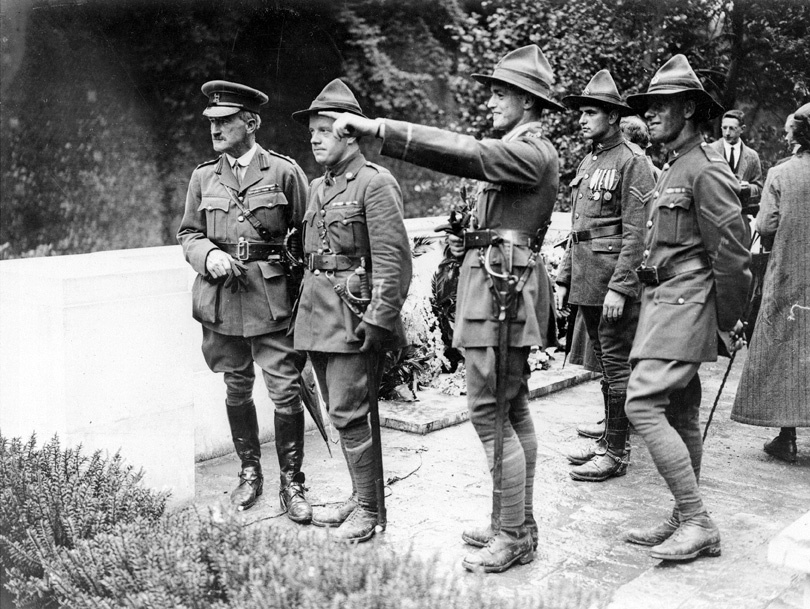
Leslie Averill points to where the scaling ladder was placed on the wall surrounding Le Quesnoy in 1918 during the dedication of the town's New Zealand memorial, 1923.
Born on 25 March 1897, Leslie Cecil Lloyd Averill volunteered for the New Zealand Expeditionary Force in 1916 and left New Zealand with the 34th Reinforcements two years later. He was posted as a second lieutenant in the 3rd New Zealand (Rifle) Brigade at Brocton camp. Averill was awarded a Military Cross for exceptional gallantry and fine leadership during the assault on Bapaume in August 1918. The exploit for which he is best remembered took place during the liberation of Le Quesnoy on 4 November 1918, which he describes below.
The time was approximately midday [on 4 November 1918] and we still had not gained entrance into Le Quesnoy. We were, however, making progress and the German fire-power from the walls had lessened. There were two outlying bastions ... Fortunately the possibility of wall climbing had been foreseen and a ladder had been provided by the engineers ... The CO was anxious that these bastions should be explored and so, with 5–6 men, I put the ladder against the wall, we climbed it and drew up the ladder behind us ... We took the ladder down on the third and sloping grassy side of this first bastion only to find a similar fortification straight ahead of us. The wall climbing of this second bastion had to be repeated and from the top of this outlying rampart I could see that we could now approach the main and final wall of this well-fortified town ... The 30-foot ladder was too short to reach from the bottom of the moat to the top of the final wall but there was one place where the ladder could be placed to reach the top. This was on a narrow stone bridge, about a foot wide, which spanned the moat and was connected with a sluice-gate ... After crossing this bridge and sluice-gate a narrow ledge ran for some 10 yards beside the wall to an arched opening, giving entrance to the town, but which – needless to say – had been completely blocked by the enemy to deny us access through the wall. It was only on this narrow wall above the sluice-gate that the ladder could reach the top.
L. C. L. Averill, First Generation New Zealander, Christchurch, 1981
After a council of war with his battalion commander, Averill returned to the spot with an assault party. He was the first of the New Zealanders to climb up the ladder over the final wall and, with the rest of his battalion swarming up behind him, he helped speed the surrender of the hundreds of Germans inside the town, who gave up once they realised the wall had been breached.
After being under the heel of the Hun for four years, the delight of the people of Le Quesnoy on being free again knew no bounds. That their liberators had come from the other side of the world to help them in their hour of need impressed them very greatly and this battle, in which 90 of the NZ Division gave their lives, was a sacrifice which will never be forgotten.
L. C. L. Averill, First Generation New Zealander, Christchurch, 1981
After the war Averill qualified as a doctor of medicine and began a successful medical practice in Christchurch. In later life he achieved prominence as a medical administrator, and in 1961 he was appointed a CMG for outstanding services to medicine and the community. In 1968 the town of Le Quesnoy appointed him Citoyen d'honneur, and in 1973 the government of France appointed him a chevalier de la Légion d'honneur. He died in Christchurch on 4 June 1981.

Community contributions